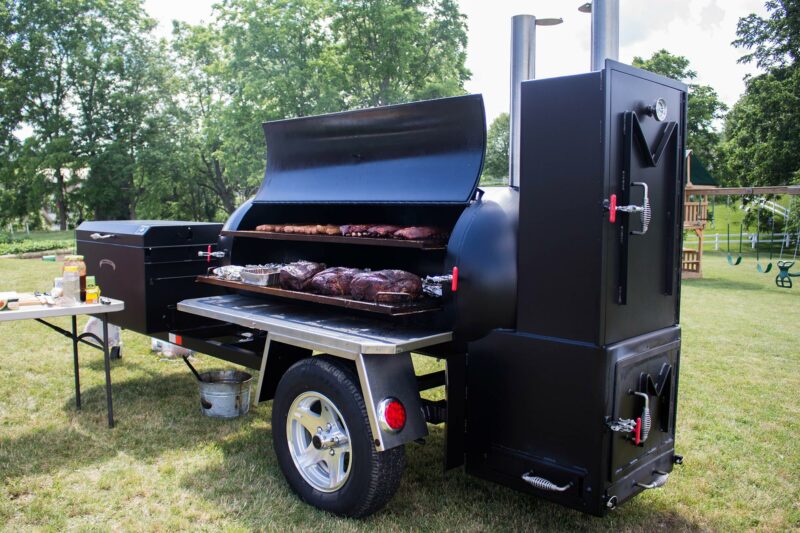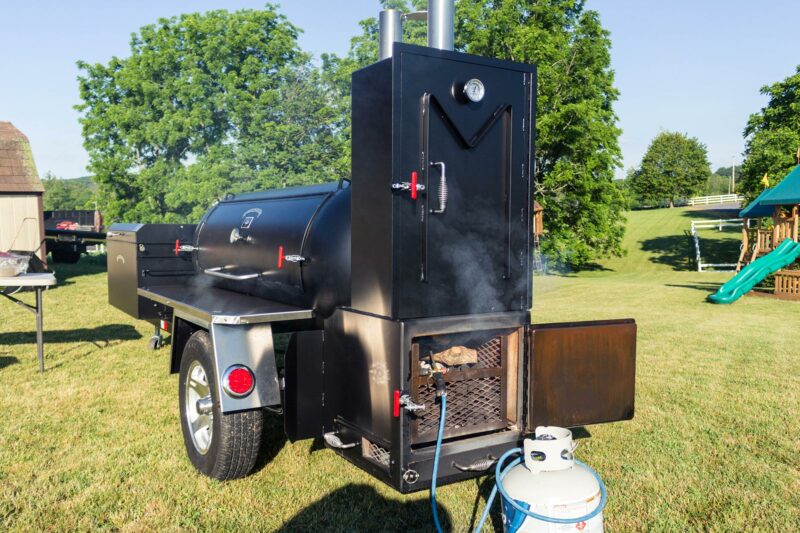August 5
A Day Out With Big Black
8 comments
Recently I published Breaking in Big Black, a story of my first cook on a Meadow Creek TS250 tank smoker with a few sweet upgrades. This post continues my adventures with Big Black when I pulled the rig to a friend’s house for an all-day cook. We only used some of the meat for the event, but leftovers are always a good thing and running a full smoker is fun work. Check out my collection of tasty photos from this cook below.

For this cook, we did 3 whole choice briskets (flat and point separated), 8 racks of back loin ribs, 12 pounds of Italian sausages, and 4 pork butts. We made burnt ends out of some of the butts and pulled the rest. Man, they were good!
For lunch I fired the front-mounted BBQ42 charcoal grill and grilled about 18 pounds of bone-in chicken thighs. Later in the day I grilled a case of skinless boneless chicken breasts on the BBQ42 for the evening meal.

Big Black has an insulated firebox and charcoal basket, so I’m experimenting with 40 pounds of charcoal and a split or two of wood at the start of a burn. Once it’s up to temp and the vents are dialed in, it will burn for about 3 hours at around 225 degrees F without adding fuel.
Please note that without the insulated firebox this would never work! Also, when you use 40 pounds of charcoal, you have to be extremely careful not to overheat this beast. The insulation holds in a tremendous amount of heat, which can actually warp the door if you overheat it. Once you get it lit, you want to shut the firebox door and slide the vents down to just a sliver, no more than 1/4″ open.
I have found that using a full basket of charcoal can amplify the hot spot in the bottom of the smoker (firebox end) because of the tremendous heat in the firebox transferring through the steel barrier. I haven’t recorded the temperature differences yet, but I did notice that one of my briskets got overdone, and I am assuming that could be helped by cutting back on the fuel and giving it more draft. I will document the temperature differences in the four corners of the smoker firing it with more or less charcoal and share my notes in an upcoming blog post.
The insulation reduces fuel cost and maintenance required on the outside of the firebox, but just like any offset smoker, an insulated firebox will require some maintenance. As you can see, the paint on the inside of my firebox door has burned off, and there is a little surface rust growing inside the firebox, so it’s important to either keep it oiled or repainted. This is not a defect in the paint job or craftsmanship. It’s simply the result of fire against paint and steel. There is no paint that can hold up to the intense heat inside the firebox, but if you keep up with it, it’s not a big deal and will certainly not affect the performance or durability of the smoker.
I seasoned some of the meat outside and the breeze wanted to blow the rub away. For the pork butts, I used Meadow Creek Brisket Rub.
I removed the membrane on the pork ribs, trimmed them a little, and seasoned them with Meadow Creek Brisket Rub.
I fired the smoker at 8:00 in the morning. By 8:30 I had the briskets on the bottom grate, and by 9:00 the pork butts. I waited until 10:15 to start the ribs since they don’t take as long.
Rolling smoke at 225 F.
The TS250 has a door on both sides which is a real dandy.
At 2:00 we wrapped the ribs in foil. The sausages went on at 2:45.
By 3:45 the ribs were unwrapped and back on the smoker.
By 4:00 we had the briskets wrapped in foil and had chunked one pork butt for burnt ends. The burnt ends went back on the smoker in a foil pan (uncovered) with a homemade sauce and Meadow Creek seasoning.
The ribs were also done around 4:00; we wrapped them in plastic wrap and aluminum foil and put them in an empty cooler until time for service.
The cooking grates in the TS250 are stainless steel and slide out on both sides for easy access.
The sausages were done around 6:00, after about 3 hours on the smoker. We sliced them into small pieces for serving… The results were fantastic.
I didn’t get any good pictures of the finished brisket but I think they were wrapped and on the smoker from about 3:45 until about 5:30, then were held in the empty cooler until 6:30. I accidentally overcooked some of the brisket. It’s tricky managing a smoker full of several different meats, but I’m looking forward to another brisket cook soon.
The BBQ42 with a rotating sandwich grate is perfect for grilling bone-in chicken, thick steaks, and sausage links, and is a perfect complement to an offset smoker.
Lighting the charcoal with a propane torch.
Ready to load the chicken onto the grate.
Grilling chicken with white sauce and Heaven Made It’s Incredible seasoning.
The vents in the bottom and in the lid give you precise control over the fire. You can also open the lid for more air if you want darker skin or need to speed up the cook.
Look at all the smoke from Royal Oak’s 100% hardwood charcoal briquettes!
Once it reaches 180-190 degrees F and the skin looks crispy, hook the grate onto the lid and use tongs to remove the chicken. It took about an hour to cook this. I should have cooked it a little longer to make the skin more crispy, but it was still amazing.
We put a homemade Alabama white sauce on the chicken while it was cooking and also tossed it in the sauce after it was de-boned and sliced. It made the best chicken sandwich I’ve ever tasted.
Around 4:45, I torched another batch of charcoal for the boneless chicken breast. It was ready around 6:30.
The rotating grate lets you turn the entire rack of meat with one hand.
Skinless boneless white meat is tricky. I was not happy with how dry some of the breast meat was. To avoid this, I should have pulled them off right as each one hit 165 degrees instead of waiting until they were all ready.
The ribs were amazing!
The burnt ends were incredible. If you’ve never tried them, you need to! Once the pork shoulder hits about 170 degrees F, put it on a cutting board, remove the bone, and slice it into small chunks. Add some sauce and seasoning and put them back on the smoker in an uncovered pan until they are as dark and smoky as you want them.
These photos were taken after the meal, so the meat looks a little dry. I made paper signs to mark the meats and taped them onto large toothpicks. The candles under the chafing pans worked great.
I hope you enjoyed the photos and notes from this cook. Post your feedback and questions in a comment below and stay tuned for more adventures on Big Black.
If you would like to talk with one of our sales reps about designing your very own Big Black, reach out to one of our dealers using our dealer locator here.
You can also learn more about the TS250 trailer in our online catalog. Click the link below, then select the options you’re interested in for suggested retail prices. To get a quote including shipping or to arrange local pickup at a dealership, click on “Request a Quote” on the TS250 page to send an inquiry to your assigned dealer.
[divider style=’full’]
[divider style=’full’]
Tags
bbq smokers, Big Black, tank smokers, ts250 smoker
Hi Lavern,
Great blog! I have a TS250 and need to upgrade to a TS500. Does the 500 come with a insulated firebox? Also can the 500 be mounted on the back end of a box trailer?
Insulated firebox is an upgrade on all the TS models. If you are interested in a custom TS500 trailer, please go to the TS500 page in our online product catalog and click on request a quote, then type in the comments what you are looking for and your nearest dealer will reach out to you to discuss the design and price.
This Black piece of art is as awesome as it can be.
A friend of mine or another friend of mine just asked for your address so I gave it to him.His name is Andre Horsey. He is from Bridgeville Delaware. He will be mailing you his info. Keep up the good work…your skills look tasty!
From my experience , reading 250° at the temp probe in the door will put you over 300° at the bottom grate by the fire box . I normally run a probe by that low grate , if I can keep that around 275°/285° than I know the rest of the chamber is good to go . The lowest temp would be at the low grate on the front . Its just a matter of moving product around once in a while .
Great blog Lavern….a lot of great ideas…..One day I hope to have a ts 250…
Do you finance theses grills
Hi, Kirk. Some of our dealers offer financing. You can ask around on our dealer locator here.